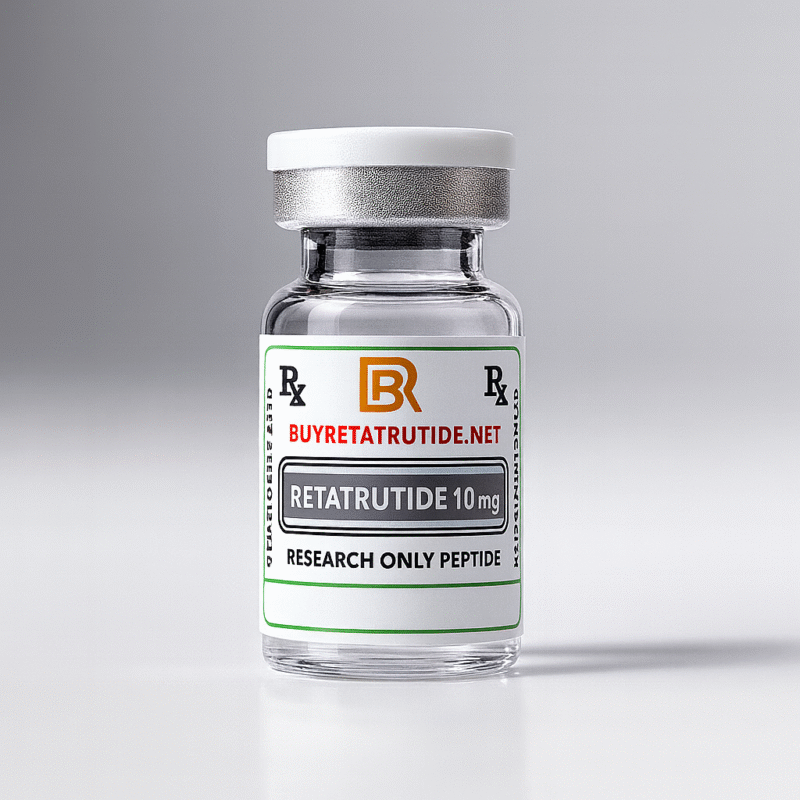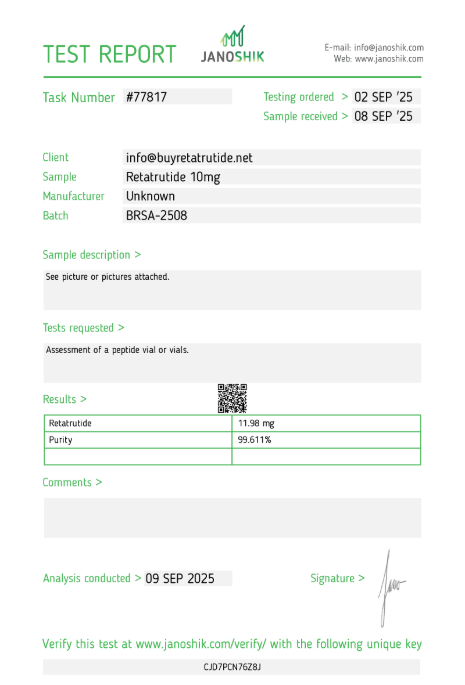- GIP Receptor Biology and Function
- Retatrutide’s GIP Receptor Activation Mechanism
- Metabolic Effects of GIP Receptor Activation
- Weight Loss Mechanisms Through GIP Activation
- Clinical Evidence for GIP Effects
- GIP Receptor Activation and Diabetes Management
- Safety Profile of GIP Receptor Activation
- Future Directions in GIP Research
GIP Receptor Biology and Function
The glucose-dependent insulinotropic polypeptide (GIP) receptor belongs to the class B G-protein coupled receptor family and is expressed throughout the body, with particularly high concentrations in pancreatic beta cells, adipose tissue, and the central nervous system. Unlike GLP-1, which primarily acts as an incretin hormone, GIP serves multiple metabolic functions that extend far beyond insulin secretion.
GIP receptor activation triggers a cascade of intracellular signalling events that influence glucose metabolism, lipid handling, and energy balance. The receptor couples to Gs proteins, leading to increased cyclic AMP (cAMP) production and activation of protein kinase A (PKA). This signalling pathway modulates numerous downstream effects, including enhanced insulin secretion, improved glucose uptake, and altered lipid metabolism.
The GIP system demonstrates remarkable plasticity and context-dependent responses. In healthy individuals, GIP promotes insulin secretion and glucose disposal. However, in states of insulin resistance and obesity, GIP’s effects can become dysregulated, contributing to metabolic dysfunction. Retatrutide’s GIP receptor activation helps restore normal GIP signalling patterns, creating a more favourable metabolic environment.
Ready to Order?
Choose your preferred amount below, fast shipping and secure checkout.
-
Reta 10mg 3 Vials
£195.00Independently verified COA. UK stock, worldwide delivery. For lab use only.
Retatrutide’s GIP Receptor Activation Mechanism
Retatrutide’s interaction with GIP receptors occurs through a sophisticated binding mechanism that optimizes receptor activation while maintaining selectivity. The medication’s molecular structure includes specific amino acid sequences that confer high affinity for the GIP receptor binding site, enabling potent and sustained activation.
The binding kinetics of retatrutide at GIP receptors differ significantly from native GIP. While endogenous GIP has a short half-life of approximately 2-3 minutes due to rapid degradation by dipeptidyl peptidase-4 (DPP-4), Retatrutide’s modified structure provides resistance to DPP-4 cleavage, extending its duration of action to several days.
This prolonged GIP receptor activation creates sustained metabolic effects that contribute to Retatrutide’s superior efficacy. The medication maintains GIP receptor signalling throughout the dosing interval, providing continuous metabolic support rather than the pulsatile effects seen with native GIP or shorter-acting agonists.
The GIP component of Retatrutide’s mechanism works synergistically with its GLP-1 and glucagon receptor activities. This triple activation creates a comprehensive metabolic response that addresses multiple aspects of metabolic dysfunction simultaneously, resulting in more robust and sustained therapeutic effects.
Metabolic Effects of GIP Receptor Activation
GIP receptor activation by Retatrutide produces a wide array of metabolic benefits that extend well beyond simple insulin secretion. The most significant effects include enhanced glucose disposal, improved lipid metabolism, and modulation of energy expenditure, all of which contribute to Retatrutide’s impressive weight loss and metabolic outcomes.
Glucose metabolism benefits from GIP receptor activation through multiple mechanisms. In pancreatic beta cells, GIP receptor stimulation enhances glucose-stimulated insulin secretion, improving the body’s ability to handle postprandial glucose loads. This effect is particularly important for individuals with type 2 diabetes, where beta cell function is often compromised.
Beyond insulin secretion, GIP receptor activation improves glucose uptake in peripheral tissues, particularly skeletal muscle and adipose tissue. This enhanced glucose disposal helps maintain normal blood glucose levels and reduces the metabolic stress associated with hyperglycaemia. The combined effect of improved insulin secretion and enhanced glucose uptake creates a powerful glucose-lowering response.
Lipid metabolism also benefits significantly from GIP receptor activation. GIP receptors in adipose tissue modulate lipolysis and lipogenesis, helping to rebalance lipid handling in favour of fat oxidation rather than storage. This effect contributes to Retatrutide’s ability to promote significant fat loss while preserving lean body mass.
Weight Loss Mechanisms Through GIP Activation
The GIP component of Retatrutide’s mechanism contributes substantially to weight loss through several distinct pathways. Unlike GLP-1, which primarily affects appetite and gastric emptying, GIP receptor activation influences energy balance through metabolic rather than behavioural mechanisms.
One of the most important weight loss mechanisms involves GIP’s effects on adipose tissue metabolism. GIP receptor activation in white adipose tissue promotes lipolysis, the breakdown of stored triglycerides into free fatty acids and glycerol. This process provides energy substrates that can be oxidized for fuel, contributing to overall energy expenditure.
GIP receptor activation also influences brown adipose tissue (BAT) activity, potentially increasing thermogenesis and energy expenditure. While the exact mechanisms remain under investigation, evidence suggests that GIP may enhance BAT function, leading to increased calorie burning even at rest.
The metabolic effects of GIP receptor activation create a favourable environment for weight loss by shifting the body’s energy balance toward fat oxidation rather than fat storage. This metabolic reprogramming, combined with the appetite-suppressing effects of GLP-1 receptor activation, creates a comprehensive approach to weight management.
Clinical Evidence for GIP Effects
Clinical trials of Retatrutide have provided compelling evidence for the importance of GIP receptor activation in achieving superior weight loss and metabolic outcomes. The medication’s triple agonist design has consistently outperformed single and dual agonists in head-to-head comparisons, with GIP activation playing a crucial role in these superior results.
Phase 2 clinical trials demonstrated that Retatrutide achieved significantly greater weight loss compared to semaglutide, a GLP-1 receptor agonist, and Tirzepatide, a dual GIP/GLP-1 agonist. These results suggest that the addition of glucagon receptor activation to GIP/GLP-1 agonism provides additional metabolic benefits that translate into superior clinical outcomes.
The weight loss achieved with Retatrutide has been particularly impressive, with many patients achieving 20-25% body weight reduction over 48 weeks of treatment. This level of weight loss approaches that achieved with bariatric surgery, representing a major advancement in medical weight management.
Metabolic improvements with Retatrutide extend beyond weight loss to include significant improvements in glycaemic control, lipid profiles, and cardiovascular risk factors. These comprehensive benefits likely result from the synergistic effects of triple receptor activation, with GIP playing a crucial role in metabolic regulation.
GIP Receptor Activation and Diabetes Management
For individuals with type 2 diabetes, GIP receptor activation by Retatrutide provides particularly important benefits for glycaemic control and diabetes management. The GIP system plays a crucial role in the incretin effect, the phenomenon whereby oral glucose produces a greater insulin response than intravenous glucose administration.
In healthy individuals, GIP contributes significantly to the incretin effect, enhancing insulin secretion in response to meals. However, in type 2 diabetes, the incretin effect is often diminished, contributing to postprandial hyperglycaemia. Retatrutide’s GIP receptor activation helps restore normal incretin function, improving postprandial glucose control.
The GIP component of Retatrutide’s mechanism also influences pancreatic alpha cell function, potentially reducing glucagon secretion and improving the insulin-to-glucagon ratio. This effect helps prevent excessive hepatic glucose production, contributing to better overall glycaemic control.
Long-term GIP receptor activation may also provide benefits for pancreatic beta cell function and survival. While the exact mechanisms remain under investigation, evidence suggests that GIP receptor activation may help preserve beta cell mass and function, potentially slowing the progression of type 2 diabetes.
Safety Profile of GIP Receptor Activation
The safety profile of GIP receptor activation by Retatrutide has been generally favourable in clinical trials, with most adverse events being mild to moderate in severity and consistent with the known effects of incretin-based therapies. The GIP component does not appear to add significant safety concerns beyond those associated with GLP-1 receptor activation.
Gastrointestinal side effects, including nausea, vomiting, and diarrhoea, remain the most common adverse events with Retatrutide. These effects are primarily attributed to GLP-1 receptor activation, though GIP receptor activation may contribute to some gastrointestinal symptoms, particularly in the early stages of treatment.
The cardiovascular safety of GIP receptor activation has been a topic of investigation, given concerns about potential effects on heart rate and blood pressure. Clinical trials have not identified significant cardiovascular safety signals associated with GIP receptor activation, though long-term cardiovascular outcomes studies are ongoing.
Hypoglycaemia risk with Retatrutide remains low, particularly when used as monotherapy. The glucose-dependent nature of GIP’s insulinotropic effects helps prevent excessive insulin secretion in the absence of elevated glucose levels, maintaining a favourable safety profile.
Future Directions in GIP Research
Research into GIP receptor activation continues to evolve, with ongoing investigations into the full spectrum of GIP’s metabolic effects and potential therapeutic applications. Understanding the complete picture of GIP receptor biology will help optimize the use of triple agonists like Retatrutide and potentially identify new therapeutic targets.
One area of active research involves the role of GIP in metabolic memory and long-term metabolic programming. Evidence suggests that GIP receptor activation may influence gene expression and metabolic pathways in ways that extend beyond the immediate effects of receptor stimulation, potentially providing lasting metabolic benefits.
The interaction between GIP and other metabolic hormones continues to be an area of investigation. Understanding how GIP receptor activation influences the secretion and action of other hormones may help explain some of Retatrutide’s unique effects and identify opportunities for further therapeutic optimization.
Personalized medicine approaches are also being explored, with research into genetic variants that may influence individual responses to GIP receptor activation. This research may eventually lead to more targeted use of triple agonists based on individual metabolic profiles and genetic characteristics.
Order Retatrutide Online
Available in 10mg vials. Select your pack size and checkout securely below.
-
Reta 10mg 3 Vials
£195.00Independently verified COA. UK stock, worldwide delivery. For lab use only.
Frequently Asked Questions
- What makes GIP receptor activation different from GLP-1 activation? GIP receptor activation primarily influences metabolic processes like glucose disposal and lipid metabolism, while GLP-1 activation focuses more on appetite suppression and gastric emptying. The combination provides comprehensive metabolic benefits.
- How does GIP receptor activation contribute to weight loss? GIP receptor activation promotes lipolysis in adipose tissue, enhances energy expenditure, and may increase brown adipose tissue activity, creating a metabolic environment favourable for weight loss.
- Is GIP receptor activation safe for long-term use? Clinical trials have shown that GIP receptor activation by Retatrutide has a favourable safety profile, with no significant safety signals identified in studies to date.
- Can GIP receptor activation help with diabetes management? Yes, GIP receptor activation helps restore normal incretin function, improves postprandial glucose control, and may help preserve pancreatic beta cell function in type 2 diabetes.
- How does Retatrutide’s GIP activation compare to other medications? Retatrutide’s triple agonist design, including GIP receptor activation, has shown superior weight loss and metabolic outcomes compared to single or dual agonists in clinical trials.
- What are the main side effects of GIP receptor activation? GIP receptor activation is generally well-tolerated, with gastrointestinal side effects being the most common, though these are primarily attributed to the GLP-1 component of Retatrutide.
- How long do the effects of GIP receptor activation last? Retatrutide’s modified structure provides resistance to degradation, allowing for sustained GIP receptor activation throughout the dosing interval, typically several days.
- Can GIP receptor activation help preserve muscle mass during weight loss? The metabolic effects of GIP receptor activation may help optimize body composition during weight loss, potentially preserving lean body mass while promoting fat loss.
- What research is ongoing regarding GIP receptor activation? Current research focuses on understanding GIP’s role in metabolic memory, interactions with other hormones, and personalized medicine approaches based on genetic variants.
- How does GIP receptor activation affect cardiovascular health? Clinical trials have not identified significant cardiovascular safety concerns with GIP receptor activation, though long-term cardiovascular outcomes studies are ongoing.

